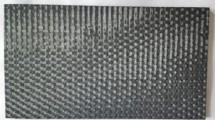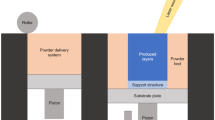Abstract
Laser-assisted machining (LAM) is a new manufacturing technology to improve the productivity of metal matrix composites (MMCs). However, there are many arguments about whether LAM is good for improving chip deformation, and there is also a lot of debate about surface integrity. The quality of surface integrity is closely correlated with the chip formation in LAM of MMCs depending on the processing conditions and constituents in composites. In this study, interaction process between 1064-nm diode laser and 45%SiCp/Al composites is theoretically described. The chip formation mechanism in LAM of 45%SiC/Al composites at different temperatures is revealed by analyzing the chip root morphology and chip chip-breaking process with an assistance of finite element model. The thermal mismatch stress of particles and matrix in the shear deformation zone are derived applying the Eshelby equivalent strain equations and thermal expansion coefficient and elastic modulus. Based on these, mechanisms of chip deformation and fracture in LAM are elucidated further. The various surface morphology (plastic side stream, surface scratches, particle pull-out, particles broken) dependent on the coupling of the force loads, thermal loads, and removal model of reinforcement particles are deeply investigated through LAM experiments. The surface morphology experiment results show that particle aggregation occurs between two or more adjacent SiC particles because the multiple SiC particles appear simultaneously at cutting path of tools. An analysis model was established to evaluate particle agglomeration in LAM according to the influence rules of tool geometry and particle size. Moreover, technological experiments focus on the effect of LAM variables, like laser power and scanning velocity on the microhardness and surface roughness of cross-section layer, mechanisms of which are analyzed from multiple perspectives.


















Similar content being viewed by others
Data availability
All data generated or analyzed during this study are included in the present article.
References
Liao Z, Abdelhafeez A, Li H, Yang Y, Diaz OG, Axinte D (2019) State-of-the-art of surface integrity in machining of metal matrix composites. Int J Mach Tools Manuf 143:63–91
Hung N, Boey F, Khor K, Phua Y, Lee H (1996) Machinability of aluminum alloys reinforced with silicon carbide particulates. J Mater Process Technol 56(1–4):966–977
Arsecularatne J, Zhang L, Montross C (2006) Wear and tool life of tungsten carbide, PCBN and PCD cutting tools. Int J Mach Tools Manuf 46(5):482–491
Hung N, Yeo S, Lee K, Ng K (1998) Chip formation in machining particle-reinforced metal matrix composites. Mater Manuf Process 13(1):85–100
Lin J, Bhattacharyya D, Ferguson W (1998) Chip formation in the machining of SiC-particle-reinforced aluminium-matrix composites. Compos Sci Technol 58(2):285–291
Karthikeyan R, Ganesan G, Nagarazan R, Pai B (2001) A critical study on machining of Al/SiC composites. Mater Manuf Process 16(1):47–60
Teng X, Chen W, Huo D, Shyha I, Lin C (2018) Comparison of cutting mechanism when machining micro and nano-particles reinforced SiC/Al metal matrix composites. Compos Struct 203:636–647
Dabade U, Jadhav M (2016) Experimental study of surface integrity of Al/SiC particulate metal–matrix composites in hot machining. Procedia Cirp 41:914–919
Han X, Xu D, Axinte D, Liao Z, Li HN (2021) On understanding the specific cutting mechanisms governing the workpiece surface integrity in metal matrix composites machining. J Mater Process Technol 288:116875
Kannan S, Kishawy H (2006) Surface characteristics of machined aluminium metal matrix composites. Int J Mach Tools Manuf 46(15):2017–2025
Bejjani R, Shi B, Attia H, Balazinski M (2011) Laser assisted turning of titanium metal matrix composite. CIRP Ann 60(1):61–64
Pramanik A, Zhang L, Arsecularatne J (2007) An FEM investigation into the behavior of metal matrix composites: tool–particle interaction during orthogonal cutting. Int J Mach Tools Manuf 47(10):1497–1506
Dandekar CR, Shin YC (2009) Multi-step 3-D finite element modeling of subsurface damage in machining particulate reinforced metal matrix composites. Compos Part A Appl Sci Manuf 40(8):1231–1239
Ge Y, Xu J, Yang H, Luo S, Fu Y (2008) Workpiece surface quality when ultra-precision turning of SiCp/Al composites. J Mater Process Technol 203(1–3):166–175
Jiang J, Sun S, Wang D, Yang Y, Liu X (2020) Surface texture formation mechanism based on the ultrasonic vibration-assisted grinding process. Int J Mach Tools Manuf 156:103595
Pramanik A, Zhang L, Arsecularatne J (2008) Machining of metal matrix composites: effect of ceramic particles on residual stress, surface roughness and chip formation. Int J Mach Tools Manuf 48(15):1613–1625
Li G, Munir K, Wen C, Li Y, Ding S (2020) Machinablility of titanium matrix composites (TMC) reinforced with multi-walled carbon nanotubes. J Manuf Process 56:131–146
Rahman Rashid R, Sun S, Palanisamy S, Wang G, Dargusch M (2014) A study on laser assisted machining of Ti10V2Fe3Al alloy with varying laser power. Inter Adv Manuf Technol 74(1):219–224
Braham-Bouchnak T, Germain G, Morel A, Lebrun J-L (2013) The influence of laser assistance on the machinability of the titanium alloy Ti555-3. Inter Adv Manuf Technol 68(9):2471–2481
Chryssolouris G, Anifantis N, Karagiannis S (1997) Laser assisted machining: an overview. J Manuf Sci Eng 119(1997):766–769
Germain G, Dal Santo P, Lebrun J-L (2011) Comprehension of chip formation in laser assisted machining. Int J Mach Tools Manuf 51(3):230–238
Melkote S, Kumar M, Hashimoto F, Lahoti G (2009) Laser assisted micro-milling of hard-to-machine materials. CIRP Ann 58(1):45–48
Wang Y, Yang L, Wang N (2002) An investigation of laser-assisted machining of Al2O3 particle reinforced aluminum matrix composite. J Mater Process Technol 129(1–3):268–272
Pachaury Y, Shin YC (2019) Assessment of sub-surface damage during machining of additively manufactured Fe-TiC metal matrix composites. J Mater Process Technol 266:173–183
El-Gallab M, Sklad M (1998) Machining of Al/SiC particulate metal matrix composites: part II: workpiece surface integrity. J Mater Process Technol 83(1–3):277–285
Niu Z, Cheng K (2019) An experimental investigation on surface generation in ultraprecision machining of particle reinforced metal matrix composites. Int J Adv Manuf Technol 105(11):4499–4507
Dandekar CR, Shin YC (2010) Laser-assisted machining of a fiber reinforced metal matrix composite. J Manuf Sci Eng 132(6):061004
Zhang H, Kong X, Yang L, Wang Y, Chi G (2015) High temperature deformation mechanisms and constitutive modeling for Al/SiCp/45 metal matrix composites undergoing laser-assisted machining. Mater Sci Eng A 642:330–339
Karthikeyan R, Ganesan G, Nagarazan R, Pai B (2001) A critical study on machining of Al/SiC composites. Mater Manuf Processes 16(1):47–60
Rice JR, Tracey DM (1969) On the ductile enlargement of voids in triaxial stress fields. J Mech Phys Solids 17(3):201–217
Chung S, Hwang BH (1994) A microstructural study of the wear behaviour of SiCp/Al composites. Tribol Int 27(5):307–314
Kumar S, Balasubramanian V (2010) Effect of reinforcement size and volume fraction on the abrasive wear behaviour of AA7075 Al/SiCp P/M composites—a statistical analysis. Tribol Int 43(1–2):414–422
Ozcatalbas Y (2003) Investigation of the machinability behaviour of Al4C3 reinforced Al-based composite produced by mechanical alloying technique. Compos Sci Technol 63(1):53–61
Przestacki D, Szymanski P, Wojciechowski S (2016) Formation of surface layer in metal matrix composite A359/20SiCP during laser assisted turning. Compos Part A Appl Sci Manuf 91:370–379
Li X, Seah W (2001) Tool wear acceleration in relation to workpiece reinforcement percentage in cutting of metal matrix composites. Wear 247(2):161–171
Funding
This research is supported by the National Natural Science Foundation of China (No. 52101197), Aviation fund (No. 2019ZE054005), Postdoctoral Foundation of China (No. 2020M680981), China Aviation Development Independent Innovation Fund Project (No. ZZCX-2019–019), Natural Science Foundation of Liaoning Province (2021-MS-264), and Shenyang Young and Middle-aged Scientific and Technological Innovation Talent Project (No. RC210439).
Author information
Authors and Affiliations
Contributions
All authors contributed to the study conception and design. Xianjun Kong is a major contributor in writing the manuscript. All authors read and approved the final manuscript.
Corresponding author
Ethics declarations
Ethics approval
Not applicable.
Consent to participate
Not applicable.
Consent for publication
Not applicable.
Conflict of interest
The authors declare no competing interests.
Additional information
Publisher's note
Springer Nature remains neutral with regard to jurisdictional claims in published maps and institutional affiliations.
Rights and permissions
Springer Nature or its licensor (e.g. a society or other partner) holds exclusive rights to this article under a publishing agreement with the author(s) or other rightsholder(s); author self-archiving of the accepted manuscript version of this article is solely governed by the terms of such publishing agreement and applicable law.
About this article
Cite this article
Kong, X., Hu, G., Wang, M. et al. Investigations on chip formation mechanism and surface integrity analysis in LAM of 45%SiCp/Al composites. Int J Adv Manuf Technol 123, 2279–2293 (2022). https://doi.org/10.1007/s00170-022-10308-x
Received:
Accepted:
Published:
Issue Date:
DOI: https://doi.org/10.1007/s00170-022-10308-x




